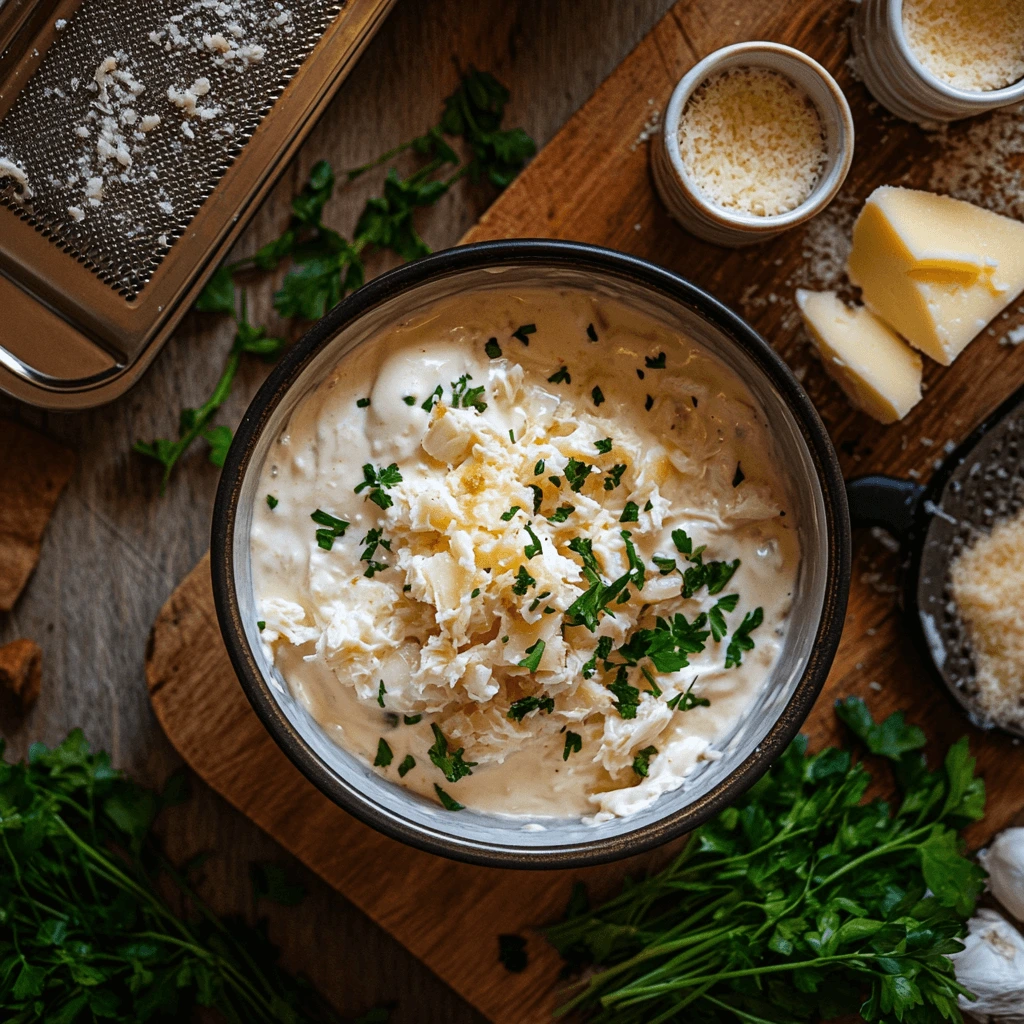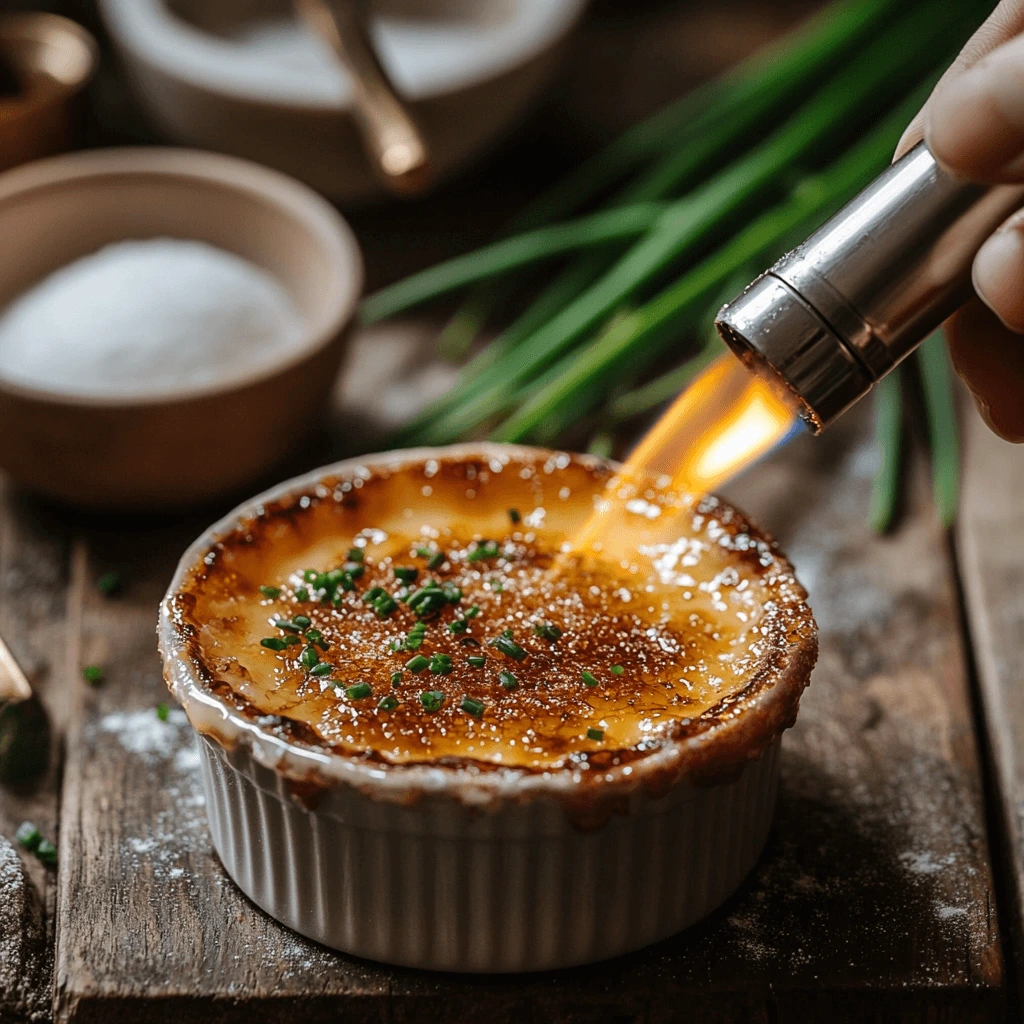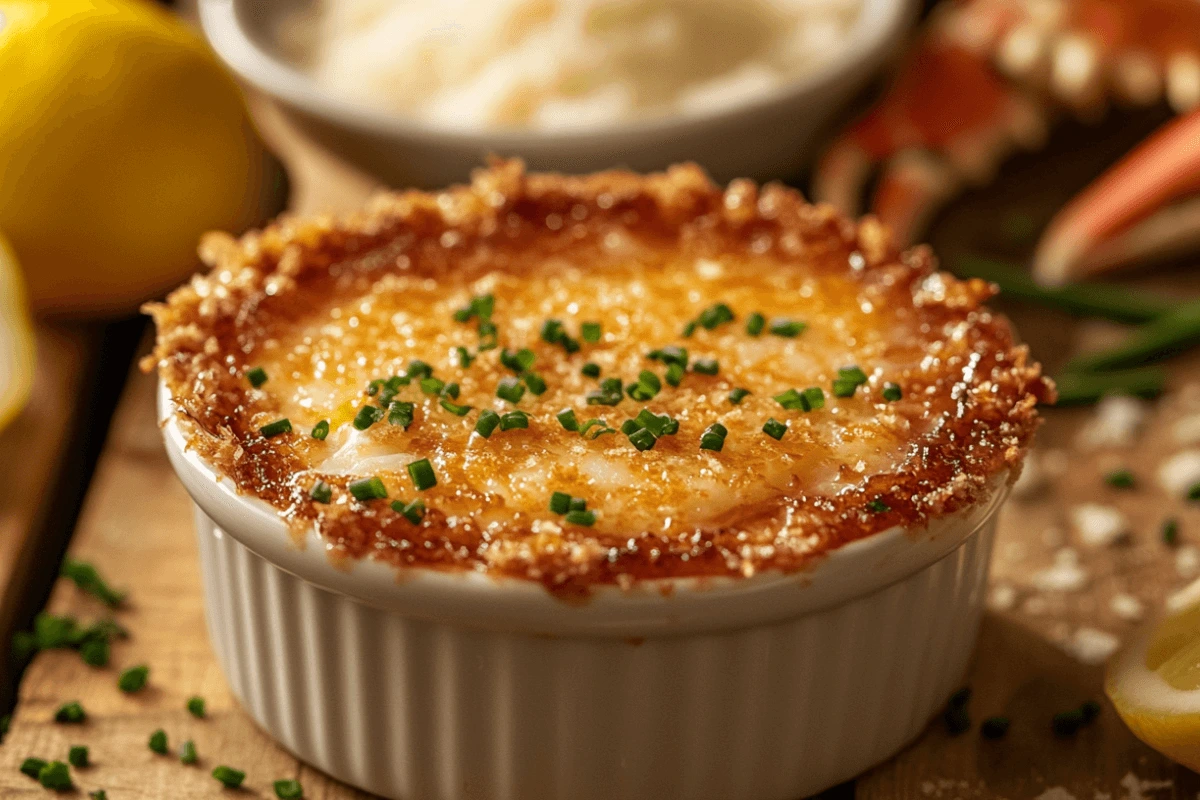Introduction to Crab Brulee Recipe
Crab Brulee Recipe is a savory twist on the traditional crème brûlée, combining the rich flavors of fresh crab with the creamy texture of custard. While classic brûlée is known for its sweetness, this innovative dish transforms it into a gourmet savory treat, perfect for seafood lovers and adventurous foodies alike.
What is Crab Brulee?
Crab brûlée is an innovative spin on the traditional crème brûlée dessert. While the classic version features a sweet custard base, crab brûlée replaces the sweetness with the savory, rich flavors of crab meat. This dish blends the creamy texture of a brûlée with the delicate taste of fresh crab, resulting in an unforgettable fusion of flavors. It’s a perfect appetizer or small plate for dinner parties or any occasion that calls for something extraordinary.
Unlike sweet brûlées, crab brûlée is served as a savory treat, with the caramelized crust acting as a delightful counterpoint to the creamy, crab-infused custard beneath. Whether you’re a seafood lover or simply a fan of inventive culinary creations, crab brûlée offers something new and exciting for your palate.
Why Try This Fusion Recipe?
This recipe is a show-stopper for several reasons:
- Unparalleled Flavor Profile: It combines the luscious texture of custard with the umami-rich taste of crab meat.
- Impressive Presentation: With its caramelized crust and gourmet appeal, this dish elevates any dining experience.
- Versatility: Serve it as a luxurious appetizer, a unique side dish, or even a main course for special occasions.
Not only does crab brûlée push the boundaries of traditional cooking, but it also proves that savory and sweet elements can coexist beautifully. If you’ve ever wanted to surprise your guests with something truly extraordinary, this is the recipe for you.
Check out more innovative recipes at Striking Recipes.
Ingredients for a Perfect Crab Brulee Recipe
Essential Ingredients List
To create a decadent crab brûlée, you’ll need the right combination of high-quality ingredients. Here’s what you’ll need for this savory masterpiece:
- Fresh Crab Meat (1 cup)
- Opt for fresh lump crab meat for the best flavor and texture. If unavailable, canned crab meat can work as a substitute.
- Heavy Cream (1 cup)
- Provides the creamy base essential for the brûlée texture.
- Egg Yolks (4 large)
- Creates the rich custard consistency that brûlée is known for.
- Parmesan Cheese (¼ cup, grated)
- Adds a subtle sharpness that pairs beautifully with crab.
- Shallots (1 small, finely chopped)
- Delivers a mild onion flavor without overpowering the dish.
- Garlic (1 clove, minced)
- Enhances the savory notes.
- Butter (1 tbsp)
- For sautéing the shallots and garlic.
- Salt and White Pepper (to taste)
- Essential for seasoning the custard.
- Granulated Sugar (2 tbsp)
- Used for the caramelized topping.
- Optional: Fresh Herbs (chives or parsley for garnish)
- Adds a pop of color and freshness when serving.
Substitutes for a Customizable Crab Brulee Recipe
Whether you’re catering to dietary needs or personal preferences, here are some substitute ideas to consider:
- Crab Meat: Swap with lobster meat or even shrimp for a different seafood twist.
- Dairy-Free Option: Use coconut cream instead of heavy cream for a lactose-free version.
- Cheese: Substitute Parmesan with Gruyère or Asiago for a different flavor profile.
- Ramekins Alternatives: If you don’t have ramekins, use shallow oven-safe bowls or mason jar lids.
Pro Tip
The quality of the crab meat is key to this dish. Always taste the crab before mixing it with the custard to ensure its freshness and flavor.
Now that we’ve gathered all the ingredients, you’re ready to move on to the next step: preparing the custard and combining it with the crab.
Step-by-Step Preparation Guide
Creating the perfect crab brûlée involves combining rich flavors with a creamy custard base, then finishing it with the signature caramelized topping. Follow these detailed steps to achieve a flawless dish.
Step 1: Preparing the Crab Mixture
- Sauté the Aromatics:
- Heat 1 tablespoon of butter in a small skillet over medium heat.
- Add the finely chopped shallots and minced garlic, cooking until soft and fragrant (about 2–3 minutes).
- Remove from heat and set aside to cool.
- Prepare the Crab Meat:
- Gently pick through the crab meat to remove any shells.
- Lightly shred the crab meat with a fork, keeping some larger chunks for texture.
- Combine Crab with Aromatics:
- In a mixing bowl, combine the sautéed shallots and garlic with the crab meat.
- Add a pinch of salt, white pepper, and a sprinkle of Parmesan cheese. Toss gently to ensure even seasoning.

Step 2: Crafting the Creamy Custard Base
- Mix the Custard Ingredients:
- In a medium bowl, whisk together the egg yolks and heavy cream until smooth.
- Add the remaining Parmesan cheese and season with a pinch of salt and white pepper. Whisk until fully combined.
- Incorporate the Crab Mixture:
- Gradually fold the seasoned crab meat into the custard mixture, ensuring even distribution without breaking up the crab too much.
Step 3: Assembling the Crab Brulee
- Prepare the Ramekins:
- Lightly grease 4 ramekins or shallow oven-safe bowls to prevent sticking.
- Divide the crab custard mixture evenly among the ramekins.
- Water Bath for Even Cooking:
- Place the filled ramekins in a deep baking dish.
- Pour hot water into the baking dish until it reaches halfway up the sides of the ramekins.
Step 4: Baking to Perfection
- Preheat the Oven:
- Set your oven to 325°F (160°C).
- Bake the Brûlée:
- Carefully place the baking dish in the oven and bake for 30–40 minutes, or until the custard is set but still slightly jiggly in the center.
- Cool the Custards:
- Remove the ramekins from the water bath and let them cool at room temperature for 10–15 minutes before chilling in the refrigerator for at least 2 hours.
Step 5: Adding the Signature Brulee Topping
- Sprinkle the Sugar:
- Once the custards are fully chilled, sprinkle ½ tablespoon of granulated sugar evenly over each ramekin.
- Caramelize the Sugar:
- Use a kitchen torch to gently heat the sugar until it melts and forms a golden, crispy crust.
- If you don’t have a torch, place the ramekins under a broiler for 1–2 minutes, watching closely to avoid burning.
Your crab brûlée is now ready to be served! The creamy custard paired with the crunchy caramelized topping creates a sophisticated dish that’s sure to impress.
Baking and Torching Tips for Beginners
Mastering the art of baking and torching is key to making a flawless crab brûlée. Here are some essential tips and techniques to ensure your dish turns out perfectly every time.
Baking the Brulee to Perfection
- Use the Water Bath Method:
- The water bath (bain-marie) is crucial for evenly cooking the custard without curdling. Always ensure the water level reaches halfway up the sides of the ramekins.
- Use hot water when filling the baking dish to minimize temperature fluctuation during cooking.
- Monitor the Cooking Time:
- Bake the custards at a low temperature (325°F/160°C) to avoid overcooking.
- The custard should have a slight jiggle in the center when shaken gently. Overbaking will result in a rubbery texture.
- Prevent Skin Formation:
- Cover the ramekins with aluminum foil while baking to prevent a skin from forming on top of the custard.
- Check for Doneness:
- Insert a knife or skewer into the custard; if it comes out clean around the edges but slightly wet in the center, it’s ready.
Torching Techniques for the Signature Caramelized Top
- Choose the Right Sugar:
- Granulated sugar is ideal for creating an even caramelized crust. Avoid powdered sugar as it melts too quickly and may burn unevenly.
- Sprinkle Sugar Evenly:
- Use a spoon to sprinkle a thin, even layer of sugar over the surface of each custard. Shake the ramekin gently to distribute the sugar.
- Master the Torch:
- Hold the torch about 2 inches away from the surface and move it in small circles. Start with the edges and gradually move to the center.
- Watch for the sugar to melt, bubble, and turn golden brown. Avoid holding the torch too long in one spot to prevent burning.
- Alternative to a Torch:
- If you don’t have a torch, you can caramelize the sugar under your oven’s broiler. Preheat the broiler and place the ramekins on the top rack for 1–2 minutes, keeping a close eye to prevent burning.
Pro Tips for Beginners
- Practice on a Test Ramekin: If you’re new to torching, start with one ramekin to get comfortable with the process before caramelizing the rest.
- Cool Slightly Before Torching: Let the custards sit at room temperature for a few minutes after refrigeration before adding the sugar and torching. This helps prevent cracking from temperature shock.
- Texture Matters: The goal is to create a thin, crispy caramelized layer that cracks easily with a spoon, revealing the creamy custard beneath.

With these tips, you’ll achieve a perfectly caramelized crust and a creamy, indulgent custard every time.
Serving Suggestions and Pairings
Once you’ve prepared your crab brûlée with its creamy custard and caramelized top, it’s time to think about presentation and complementary pairings to elevate the dining experience.
Garnishing Tips for Presentation
- Fresh Herbs for Contrast:
- Sprinkle finely chopped chives, parsley, or dill over the caramelized crust to add a pop of green and a hint of freshness.
- Citrus Zest for a Bright Finish:
- Grate a small amount of lemon or orange zest over the top. The citrus aroma beautifully complements the savory crab custard.
- Seafood Accent:
- Garnish each ramekin with a small piece of lump crab meat or a tiny shrimp for an elegant touch.
- Edible Flowers:
- For an extra-special presentation, add a few edible flowers like nasturtiums or violas for color and sophistication.
- Serve with a Stylish Touch:
- Present the brûlées on a wooden tray or with a folded napkin under each ramekin for a polished, restaurant-style appearance.
Best Side Dishes and Drinks to Complement
- Side Dishes:
- Freshly Baked Bread: A crusty baguette or herbed focaccia pairs perfectly with the rich custard, allowing diners to scoop up every bit.
- Light Salad: A mixed green salad with a lemon vinaigrette or arugula topped with shaved Parmesan balances the creaminess of the brûlée.
- Seafood Pairings: Serve alongside grilled scallops or a shrimp cocktail for a cohesive seafood-inspired menu.
- Drink Pairings:
- Cocktails: A citrusy gin-based cocktail, such as a French 75, refreshes the palate between bites.
- Non-Alcoholic Options: Sparkling water with a splash of lime or a cucumber cooler provides a refreshing, alcohol-free alternative.
Pro Tips for Serving
- Serve Immediately After Torching: The caramelized sugar is best when freshly torched, as it retains its crunch and doesn’t soften from the custard underneath.
- Adjust Portions for the Occasion: Crab brûlée can be served as a small appetizer in ramekins or as a centerpiece in larger portions for a main course.
- Encourage Tasting Layers: Suggest that diners crack the caramelized top with a spoon to enjoy the satisfying crunch before savoring the creamy custard.
With these garnishing and pairing ideas, your crab brûlée becomes more than a dish—it’s an experience.
Common Mistakes to Avoid
Creating the perfect crab brûlée requires attention to detail. Avoiding these common mistakes will ensure your dish comes out creamy, flavorful, and beautifully presented every time.
1. Overcooking the Custard
- Why It Happens: Overcooking often results from baking at too high a temperature or leaving the custard in the oven for too long.
- How to Avoid It:
- Always bake at a low, controlled temperature (325°F/160°C).
- Keep an eye on the custard; it should still have a slight jiggle in the center when done.
- Remove from the oven promptly and allow it to cool.
2. Skipping the Water Bath (Bain-Marie)
- Why It’s Important: The water bath ensures even heat distribution, preventing the custard from curdling or cracking.
- How to Do It Right:
- Use a deep baking dish and pour in hot water until it reaches halfway up the sides of the ramekins.
- Make sure the water is hot but not boiling, as this could affect the cooking process.
3. Uneven Caramelization
- Why It Happens: Applying sugar unevenly or using improper torching techniques can lead to a patchy or burnt crust.
- How to Avoid It:
- Use granulated sugar and spread it evenly across the top of each custard.
- Hold the torch 2 inches from the surface and move it in small circles to caramelize the sugar evenly.
4. Using Low-Quality Crab Meat
- Why It Matters: The flavor of the crab is the star of the dish, so low-quality or improperly prepared crab meat will affect the overall taste.
- How to Avoid It:
- Always use fresh, high-quality lump crab meat for the best flavor.
- If using canned crab, rinse and drain it thoroughly to remove any briny taste.
5. Improper Custard Consistency
- Why It Happens: The custard may turn out too runny or too firm if the egg-to-cream ratio is off.
- How to Avoid It:
- Follow the recipe closely, ensuring the correct balance of egg yolks, heavy cream, and other ingredients.
- Whisk the custard mixture thoroughly to avoid lumps and achieve a smooth texture.
6. Neglecting Proper Chilling Time
- Why It’s Important: Chilling allows the custard to set and enhances the flavors. Skipping this step can result in a warm, overly soft custard.
- How to Do It Right:
- Refrigerate the baked custard for at least 2 hours before adding the caramelized topping.
- For the best results, chill overnight if possible.
7. Using the Wrong Type of Dish
- Why It Matters: The shape and material of the dish affect cooking time and caramelization.
- How to Avoid It:
- Use shallow, oven-safe ramekins or dishes to ensure even cooking and a proper caramelized topping.
- Avoid deep dishes, as they may lead to unevenly cooked custard.
8. Forgetting to Taste and Season
- Why It’s Crucial: Proper seasoning ensures that the flavors of the crab and custard shine.
- How to Avoid It:
- Taste the crab mixture before combining it with the custard to ensure it’s seasoned properly.
- Adjust salt and white pepper levels as needed for a balanced flavor.
Pro Tip:
Practice makes perfect! If you’re trying this recipe for the first time, consider making a test batch to refine your techniques before serving it at a big event.
By steering clear of these common pitfalls, you’ll create a crab brûlée that’s silky, flavorful, and garnished with the perfect caramelized crust.
FAQs About Crab Brulee and Crème Brûlée
To help you perfect your crab brûlée and understand its roots, here are answers to some commonly asked questions about this unique dish and its classic dessert counterpart.
What is the secret of crème brûlée?
The secret to a perfect crème brûlée lies in achieving the right balance between the silky custard and the caramelized sugar topping. Here’s what makes it exceptional:
- Custard Consistency: Using a proper ratio of egg yolks to cream ensures a rich, smooth texture.
- Caramelized Topping: A thin, evenly torched sugar crust provides the signature crack when tapped with a spoon.
- Gentle Cooking: Baking in a water bath prevents curdling and keeps the custard creamy.
For crab brûlée, these same principles apply, but with the added complexity of balancing savory flavors with the creamy base.
What’s the difference between crème brûlée and custard?
While crème brûlée and custard share a similar base, they differ in texture, cooking methods, and presentation:
- Crème Brûlée:
- Topped with a caramelized sugar crust that adds crunch.
- Baked in a water bath and served chilled.
- Often served in individual ramekins.
- Custard:
- Served plain or topped with whipped cream or fruit instead of caramelized sugar.
- Can be baked, steamed, or cooked on the stovetop.
- Used in a variety of dishes, from pies to trifles.
Crab brûlée builds on the crème brûlée concept but transforms it into a savory dish with the addition of crab meat and seasonings.
What can I use instead of ramekins for crème brûlée?
If you don’t have ramekins, don’t worry! Here are some alternatives:
- Shallow Oven-Safe Bowls: Small ceramic or glass bowls work well.
- Mason Jar Lids: The flat shape is perfect for achieving a thin layer of custard with an evenly caramelized top.
- Mini Pie Dishes: These are great for larger portions.
- Teacups or Espresso Cups: Ensure they’re oven-safe for use in a water bath.
What is the English version of crème brûlée?
The English version of crème brûlée is often referred to as “burnt cream.” It originates from the French term “crème brûlée,” which translates to “burnt cream,” referring to the caramelized sugar topping. In England, similar custards have been enjoyed for centuries, but the French version popularized the addition of the signature sugar crust.
Crab brûlée doesn’t have a traditional English equivalent—it’s a modern twist that blends classic culinary techniques with savory seafood.
Quick Recap of Key Points:
- Mastering the custard texture and caramelized topping is the secret to a great brûlée.
- Crème brûlée differs from custard in its signature sugar crust and serving style.
- Ramekin substitutes include mason jar lids, shallow bowls, and mini pie dishes.
- “Burnt cream” is the English equivalent of crème brûlée, but crab brûlée is a contemporary innovation.
By understanding these FAQs, you’ll not only gain insight into the classic dessert but also feel confident experimenting with its savory seafood variation.
Nutritional Information and Customization Ideas
Crab brûlée is not only a flavorful dish but also one that can be customized to suit various dietary preferences. Here, we’ll break down its nutritional profile and share creative ways to make it your own.
Nutritional Breakdown (Per Serving – Approximate Values)
- Calories: 280–320
- Protein: 10–12 grams (from crab and eggs)
- Fat: 24–28 grams (from heavy cream and egg yolks)
- Carbohydrates: 6–8 grams (from sugar and aromatics)
- Sodium: 450–500 milligrams (varies depending on seasoning and crab meat source)
This makes crab brûlée a rich, indulgent dish that’s best enjoyed in moderation or paired with lighter sides.
Customization Ideas
- Dietary Adjustments:
- Dairy-Free: Replace heavy cream with coconut cream or almond milk for a lactose-free version. Note that this may slightly alter the texture.
- Low-Carb: Skip the caramelized sugar topping to reduce carbohydrates, focusing instead on the savory custard.
- Gluten-Free: The recipe is naturally gluten-free, making it suitable for those with gluten sensitivities.
- Protein Alternatives:
- Lobster Brûlée: Swap crab meat with lobster chunks for a luxurious variation.
- Vegetarian Option: Replace crab meat with finely chopped roasted mushrooms or caramelized onions for a vegetarian brûlée.
- Flavor Enhancements:
- Spicy Twist: Add a pinch of cayenne pepper or smoked paprika to the custard for a hint of heat.
- Herb-Infused: Mix fresh dill or tarragon into the custard for an aromatic flavor boost.
- Citrus Zest: Incorporate a small amount of lemon or lime zest for brightness.
- Creative Presentations:
- Mini Portions: Serve in bite-sized ramekins for cocktail parties or appetizer platters.
- Layered Elegance: Add a thin layer of sautéed spinach or mashed potatoes under the custard for a layered dish.
- Seafood Medley: Combine crab with other seafood, like scallops or shrimp, for a multi-flavored brûlée.
Pro Tips for Healthier Adjustments
- Opt for half-and-half instead of heavy cream to reduce fat content.
- Use natural sweeteners, like coconut sugar, for the caramelized topping.
- Serve with fresh greens or a light citrus salad to balance the richness.
Why Customize?
Customizing crab brûlée allows you to cater to dietary needs or experiment with flavors, making it a versatile dish for any occasion. Whether you’re going dairy-free, vegetarian, or looking to add extra seafood flair, these ideas will inspire creativity in your kitchen.
Storing and Reheating Crab Brulee
Crab brûlée is a dish that can be prepared ahead of time, making it convenient for dinner parties or meal prep. Here’s how to store it properly and reheat it without compromising its creamy texture and caramelized topping.
How to Store Crab Brulee for Maximum Freshness
- Refrigerating Leftovers:
- Allow the crab brûlée to cool completely at room temperature after baking.
- Cover each ramekin tightly with plastic wrap or aluminum foil.
- Store in the refrigerator for up to 2 days.
- Freezing for Longer Storage:
- For extended storage, you can freeze the custard before adding the sugar topping.
- Cover each ramekin with plastic wrap and then with aluminum foil to prevent freezer burn.
- Store in the freezer for up to 1 month.
- Thawing Frozen Brulee:
- Transfer the ramekins from the freezer to the refrigerator and let them thaw overnight.
- Avoid microwaving to thaw, as it can cause the custard to separate.
Reheating Tips Without Losing Flavor
- Reheating the Custard:
- Preheat your oven to 300°F (150°C).
- Place the ramekins in a water bath and warm them in the oven for 10–15 minutes, just until the custard is warmed through.
- Avoid overheating, as it may curdle the custard.
- Restoring the Caramelized Topping:
- If you’ve already caramelized the sugar, note that reheating may soften the crust. To restore its crunch:
- Add a thin layer of sugar on top of the custard.
- Use a kitchen torch or broiler to caramelize the sugar again.
- If you’ve already caramelized the sugar, note that reheating may soften the crust. To restore its crunch:
- Caramelizing After Reheating:
- If you froze or refrigerated the brûlée without the topping, reheat the custard first, then sprinkle sugar and caramelize it for a freshly made finish.
Tips for Best Results
- Reheat Individual Portions: Only reheat the portions you plan to serve to keep the rest fresh.
- Avoid Microwaving: Microwaving can unevenly heat the custard and ruin its creamy texture.
- Serve Immediately After Reheating: For the best flavor and texture, serve the brûlée as soon as it’s reheated and caramelized.
Proper storage and reheating techniques ensure your crab brûlée retains its rich, creamy consistency and signature caramelized topping, even when prepared ahead of time.
Conclusion and Final Thoughts
Crab brûlée is more than just a recipe—it’s an experience that blends the luxurious creaminess of a classic brûlée with the savory depth of fresh crab. Whether served as a show-stopping appetizer or a unique entrée, this dish is sure to impress your guests and elevate your culinary repertoire.
Why Crab Brulee Is a Must-Try Recipe
- Flavor Fusion: The combination of rich custard, succulent crab meat, and a caramelized sugar crust creates a perfect harmony of savory and sweet.
- Versatile and Customizable: From dietary adjustments to creative garnishes, crab brûlée can be tailored to fit any occasion or preference.
- Show-Stopping Presentation: Its golden crust and elegant serving style make it an unforgettable addition to any meal.
Encouraging Readers to Share Their Experience
Now that you’re equipped with all the tips, techniques, and ideas to perfect this dish, it’s time to try it for yourself! Whether you’re hosting a dinner party or indulging in a quiet gourmet treat, crab brûlée is a dish worth savoring.
Have you tried making crab brûlée? We’d love to hear about your experience! Share your creations, tips, and variations in the comments below.
Don’t miss our other innovative seafood recipes at Striking Recipes.

